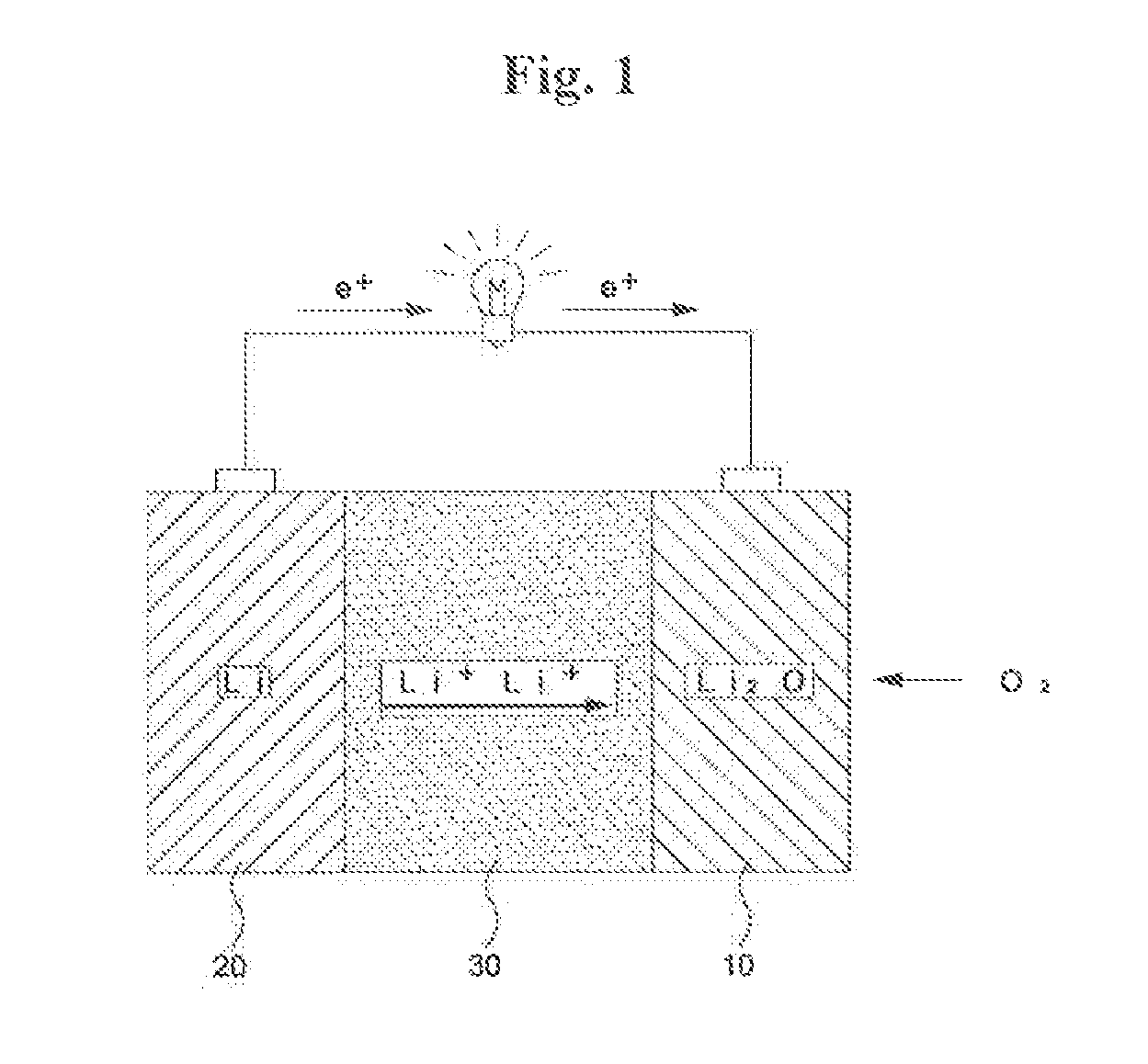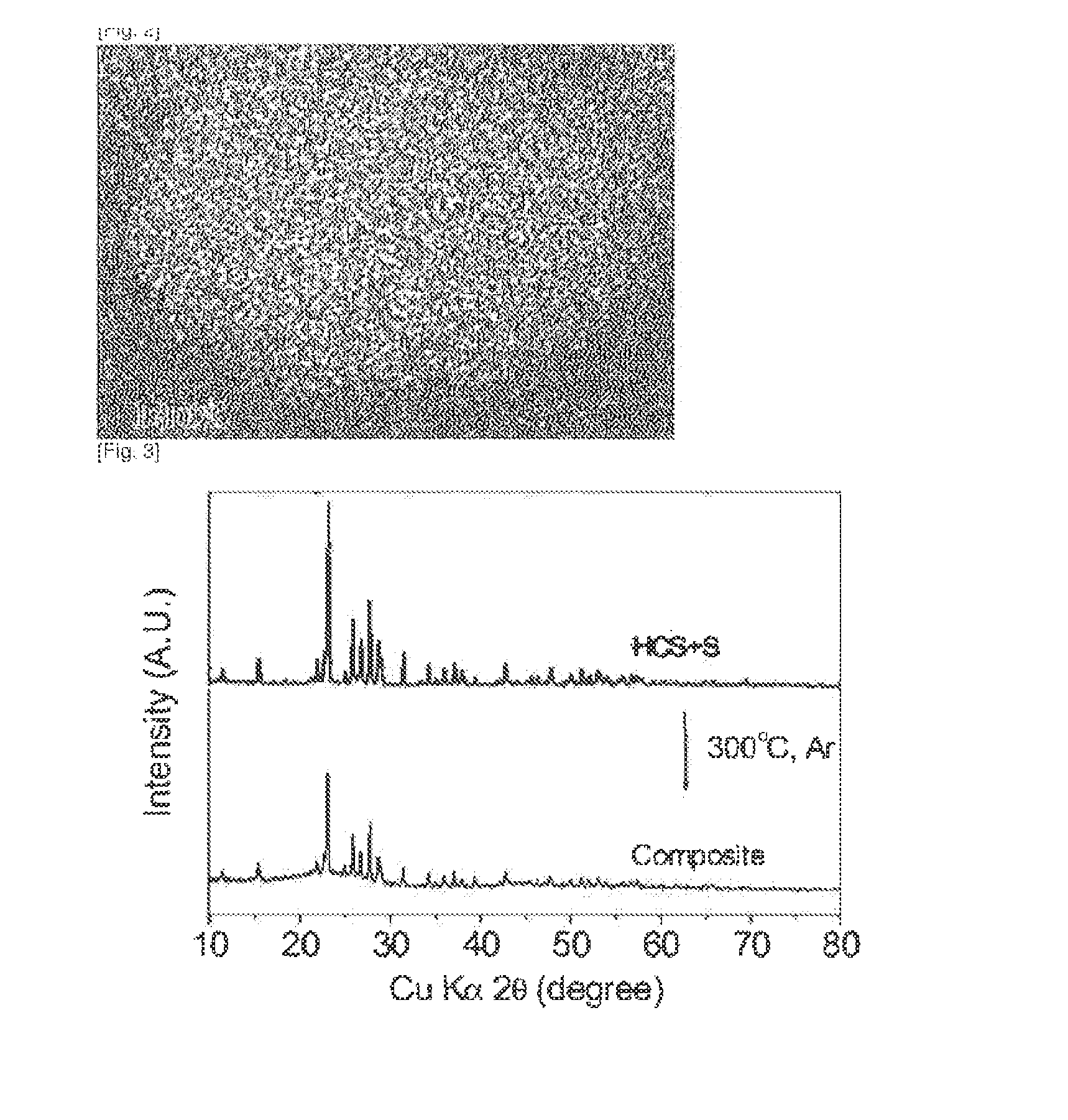Lithium-air battery
a battery and air technology, applied in the field of lithium-air batteries, can solve the problems of reducing the charging/discharging characteristic of air batteries, and achieve the effects of preventing volatilization of electrolyte, avoiding degradation of charging/discharging characteristics of batteries, and using for a long time without safety problems
- Summary
- Abstract
- Description
- Claims
- Application Information
AI Technical Summary
Benefits of technology
Problems solved by technology
Method used
Image
Examples
example 1
[0038]TGP-H-30 carbon paper (Torray Industries Inc.) as a positive electrode was coated with each electron-conducting material of the following Table 1 as an electron-conducting material. The electron-conducting material 80 wt % was mixed with PVDF 20 wt % as a binder to prepare slurry, and coated on the TGP-H-30 carbon paper (Torray Industries Inc.) to the density of 1.0±0.1 mg carbon / cm2, and then dried under vacuum at 100° C. for 12 hrs to remove residual solvent.
TABLE 1Electron-conducting materialExample 1-1Super PExample 1-2Vulcano carbonExample 1-3CMKExample 1-4CNTExample 1-5Graphene oxideExample 1-6Acetylene blackExample 1-7Ketjen black
[0039]A 2032 coin-type cell was manufactured by using a gas diffusion layer (GDL) coated with the electron-conducting material prepared as described above as an air electrode, lithium metal as a negative electrode, (TEGDME)4-LiCF3SO3, which was prepared by dissolving LiCF3SO3 salt in TEGDME (Aldrich) at molar ratio of 4:1, as an electrolyte and...
example 2
[0042]TGP-H-30 carbon paper (Torray Industries Inc.) as a positive electrode was coated with Super P as an electron-conducting material with the same condition with Example 1.
[0043]A 2032 coin-type cell was manufactured by using a gas diffusion layer (GDL) coated with the electron-conducting material prepared as described above as an air electrode, lithium metal as a negative electrode, each electrolyte of the following Table 2 as an electrolyte and a separator (Celgard LLC, Celgard 3501) of porous polyethylene film.
TABLE 2Result ofMeasuringCharging / DischargeDischargingElectrolyte UsedTemperatureCharacteristicsExample(TEGDME)4-LiCF3SO3RoomFIG. 92-1temperature50° C.FIG. 1070° C.FIG. 11ExamplePEO-(TEGDME)4-LiCF3SO350° C.FIG. 122-270° C.FIG. 13ExamplePEGDME-LiCF3SO3RoomFIG. 142-3temperature50° C.FIG. 1570° C.FIG. 16ExamplePEO-LiCF3SO370° C.FIG. 172-4
[0044]Charging / discharging capacity of the lithium-air batteries manufactured in Examples 2-1 to 2-4 was measured at the temperature of Ta...
example 3
[0046]Positive electrodes and air batteries were manufactured as described in Example 1 by using TGP-H-30 carbon paper (Torray Industries Inc.) as a positive electrode and Super P as an electron-conducting material, and mixing the Super P 80 wt % with each binder of the following Table 3 20 wt %.
TABLE 3Electrolyte UsedExample 3-1PVdFExample 3-2PEOExample 3-3Kynar
[0047]Charging / discharging capacity of the lithium-air batteries manufactured in Examples 3-1 to 3-3 was measured, and the results were shown in FIGS. 18 to 20.
[0048]As shown in FIGS. 18 to 20, it can be found that the charging voltage and the discharging voltage vary depending on types of binders, but similar each other.
PUM
| Property | Measurement | Unit |
|---|---|---|
| electron-conducting | aaaaa | aaaaa |
| permeable | aaaaa | aaaaa |
| voltage | aaaaa | aaaaa |
Abstract
Description
Claims
Application Information
 Login to View More
Login to View More - R&D
- Intellectual Property
- Life Sciences
- Materials
- Tech Scout
- Unparalleled Data Quality
- Higher Quality Content
- 60% Fewer Hallucinations
Browse by: Latest US Patents, China's latest patents, Technical Efficacy Thesaurus, Application Domain, Technology Topic, Popular Technical Reports.
© 2025 PatSnap. All rights reserved.Legal|Privacy policy|Modern Slavery Act Transparency Statement|Sitemap|About US| Contact US: help@patsnap.com



